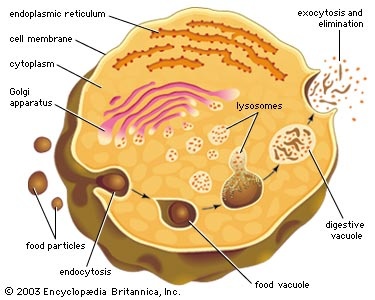lysosome
biology
 subcellular organelle that is found in all eukaryotic cells and is responsible for the cell's digestion of macromolecules, old cell parts, and microorganisms. Each lysosome is surrounded by a membrane that maintains an acidic environment within the interior via a proton pump. Lysosomes contain a wide variety of hydrolytic enzymes (acid hydrolases) that break down macromolecules such as nucleic acids, proteins, and polysaccharides. These enzymes are active only in the lysosome's acidic interior; their acid-dependent activity protects the cell from self-degradation in case of lysosomal leakage or rupture, since the pH of the cell is neutral to slightly alkaline. Lysosomes were discovered by the Belgian cytologist Christian René de Duve (Duve, Christian René de) in the 1950s.
subcellular organelle that is found in all eukaryotic cells and is responsible for the cell's digestion of macromolecules, old cell parts, and microorganisms. Each lysosome is surrounded by a membrane that maintains an acidic environment within the interior via a proton pump. Lysosomes contain a wide variety of hydrolytic enzymes (acid hydrolases) that break down macromolecules such as nucleic acids, proteins, and polysaccharides. These enzymes are active only in the lysosome's acidic interior; their acid-dependent activity protects the cell from self-degradation in case of lysosomal leakage or rupture, since the pH of the cell is neutral to slightly alkaline. Lysosomes were discovered by the Belgian cytologist Christian René de Duve (Duve, Christian René de) in the 1950s.Lysosomes originate by budding off from the membrane of the trans-Golgi network, a region of the Golgi complex responsible for sorting newly synthesized proteins, which may be designated for use in lysosomes, endosomes, or the plasma membrane. The lysosomes then fuse with membrane vesicles that derive from one of three pathways: endocytosis, autophagocytosis, and phagocytosis. In endocytosis, extracellular macromolecules are taken up into the cell to form membrane-bound vesicles called endosomes that fuse with lysosomes. Autophagocytosis is the process by which old organelles are removed from a cell; they are enveloped by internal membranes that then fuse with lysosomes. phagocytosis is carried out by specialized cells (e.g., macrophages) that engulf large extracellular particles such as dead cells or foreign invaders (e.g., bacteria) and target them for lysosomal degradation. Many of the products of lysosomal digestion, such as amino acids and nucleotides, are recycled back to the cell for use in the synthesis of new cellular components.
Lysosomal storage diseases are genetic disorders in which a genetic mutation affects the activity of one or more of the acid hydrolases. In such diseases, the normal metabolism of specific macromolecules is blocked and the macromolecules accumulate inside the lysosomes, causing severe physiological damage or deformity. Hurler's syndrome, which involves a defect in the metabolism of mucopolysaccharides, is a lysosomal storage disease.
- Saint Siricius
- Saint Sixtus I
- Saint Sixtus II
- Saint Sixtus III
- Saint Soter
- Saints Sergius and Bacchus
- Saint Stanislaus of Kraków
- Saint Stephen
- Saint Stephen Harding
- Saint Stephen I
- Saint Stephen of Perm
- Saint Stephen's Cathedral
- Saint Stephen's Crown
- Saint Swithin's Day
- Saint Swithun
- Saint Sylvester I
- Saint Symeon the New Theologian
- Saint Symmachus
- Saint Telesphorus
- Saint Teresa of Ávila
- Saint Theodore of Canterbury
- Saint Theodore Studites
- Saint Theodosius of Palestine
- Saint Theophanes the Confessor
- Saint Theophilus of Alexandria